UNSC Vehicles
Grizzly

A variant of the classic 'Scorpion' tank featured in the Halo trilogy. This modification, designed by Sergeant Forge himself, features a double barreled turret for increased fire and a much improved armour design.
Gremlin
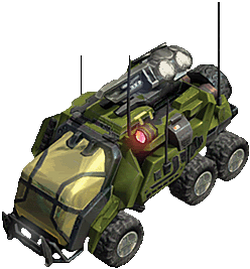
The Gremlin is a combat support unit that aids UNSC forces by using a focused EMP to disable enemy vehicles and defenses, allowing the humans time to take them out or evade them. Vulnerable against infantry, they could modify their beam to provide a weak, close range defense.
Rhino
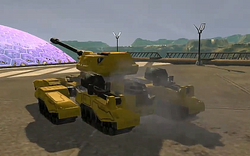
A long range artillery unit, the UNSC were field-testing these units to try out different weapon methods. Essentially a larger version of the Scorpion with a larger turret that could 'lock down' for longer range fire, a number of these units were modified to use plasma-based weaponry like Covenant units. Some of these prototypes were on board the Pillar of Autumn when it was tasked to Arcadia and they were used to disable a large Covenant shield by the Spirit of Fire crew.
Wolverine
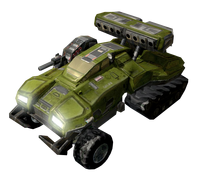
An anti-air unit employed by the UNSC, featuring large laser-tracking missile launchers to defend bases and ground units from air attack, capable of taking down Covenant Banshees in seconds. It has only light armour do to the need to track air units, but it can adapt it's missile launchers to take out ground units if under attack.
Cobra
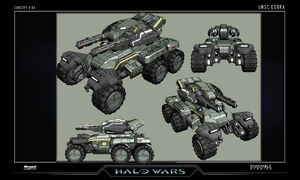
A slow, but powerful anti-vehicle unit the Cobra uses two powerful rail guns to decimate enemy forces. They need to be protected by other units due to their slow rate of fire, but the power of their weapon is able to decimate even the strongest opposition, especially when they lock down.
Cyclops
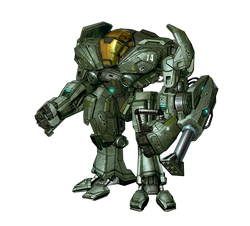
An offshoot of the project that produced Mjolnir powered armour, Cyclopes were modified to provide support instead of being combat units. Used to maintain and repair structures and vehicles, they repaired Spirit of Fire's generator during a Covenant attack. They could also use their abilities to take buildings apart is needed and could deal devastating blows to any infantry who got close.
Covenant Vehicles
Locust
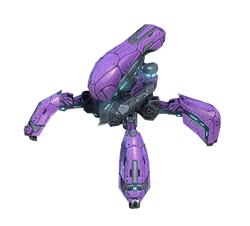
Similar to the Scarab in it's power and mode of transport, the Locust is much smaller, tough it still stands tall over a Scorpion tank. It has one weapon, a long range focused plasma beam, which earns it the title 'building killer'. It is a slow firing weapon, which makes it vulnerable to fast moving targets such as air units. However the Locust has strong shields and is incredibly maneuverable, able to scale cliff faces with it's strong legs.
The Covenant were also building a 'Super Scarab' on Arcadia, much larger than even the gigantic vehicle feared by many. The UNSC forces destroyed this vehicle before it could be finished.
UNSC Aerial
Shortsword

A cousin to the UNSC's space fighter the 'Longsword' this smaller fighter is designed for tactical strikes on ground unit, initiating lightning-fast bombing runs from orbit. Able to precisely drop explosive ordnance, or special weapons such as cryo bombs, Shortswords provide welcome support to ground units.
Hawk
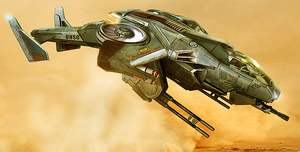
A powerful air-support vehicle, based on the design of the Hornet, this unit was faster and featured a mounted 'Spartan Laser' in addition to it's powerful chain gun to deliver devastating firepower. In large numbers these units were nearly unstoppable, however repair problems caused them to be discontinued, meaning the UNSC relied on the Hornet for air support for most of the war.
Vulture

One of the most powerful units the UNSC has at it's disposal, the Vulture is reserved for the heaviest conflicts. Fitted with front mounted auto-cannons and multiple missile launchers the Vulture can unleash a barrage of fire, unleashing heavy damage over a wide area.
The Spirit of Fire is also equipped with 'Pods' which can ferry prefabricated Firebases onto an area from orbit.
Covenant Aerial
Vampire

An aerial unit with heavy firepower, the Vampire is used primarily as an anti-air unit due to it's powerful stasis beam which can cause aircraft to either be frozen in place or lose power and crash. It attacks with a heavy needler which has a high rate of fire suitable for tracking and taking down aircraft.
Forerunner Aerial
Super Sentinel

Simply a larger, more powerful of the sentinels encountered in the trilogy, these Sentinels were activated when the Flood reached the centre of the Shield world.
Flood Aerial
Swarm Form
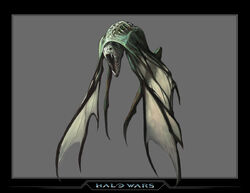
Another animalistic flood form on the Shield World, these flying creatures use powerful barbs to attack targets from the air, swarming them in large numbers, wheeling around them to evade attacks.
I don't have a decent picture, but there are also Bomber Forms that fly and drop infection forms into infantry to convert them into Flood soldiers.
Nearly there - but I think we do have to refer to...
Spaceships
Spirit of Fire
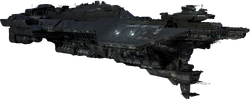
This Phoenix class ship was originally designed to transport supplies for new colonies, able to drop large structures and supplies from orbit and oversee operations. With the outbreak of war it was refitted to serve as a warship and as a ground support, now dropping in bases and heavy ordnance. If needed the Spirit could give heavy damage to other ships or structures with it's MAC cannon.
Unidentified Forerunner Ship
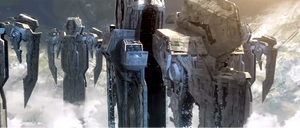
Sitting at the heart of this Covenant plot, this powerful array of starship were hidden in the Forerunner shield world and would be used by the Covenant to annihilate humanity were it not for the Spirit of Fire crew's brave actions. As seen in Halo Legends these ships had firepower beyond even the best Covenant ship and would have been an unstoppable threat to humanity.
And that's it - Halo Wars was a great experience and I hope maybe some of these vehicles turn up in future projects such as Reach.

No comments:
Post a Comment